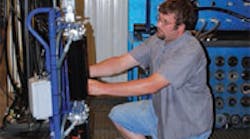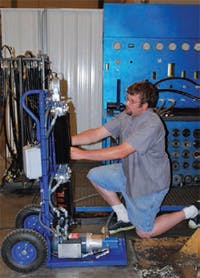Tandem hydraulic filter cart works double time removing hydraulic fluid contamination
Appeared in print as "Hydraulic filter cart works double time"
Off-line filtration is a great way to get fluid clean in a hydraulic system. It should be used in conjunction with regular hydraulic system filtration, rather than as a substitute for it. But because off-line systems each need their own pump, motor, filters, plumbing and accessories, providing an off-line system for every hydraulic system in a plant can be an expensive proposition.
That’s where filter carts come in. A filter cart is a portable off-line filtration system that can be moved from one system to another. So a single filter cart can serve multiple hydraulic systems. Y2K Fluid Power, Sioux Falls, S.D., has taken this concept one step further with its tandem filter cart.
The tandem filter cart has two distinct sets of filter elements that allow filtering two different grades of hydraulic and/or lubricating oil using only one filter cart. The key to this capability is an on-board manual flow control valve that isolates one set of filters when flushing one grade of oil and vice versa. Therefore, two grades of fluid can be cleaned without any cross contamination of either.
Driven by a 115-V electric motor, the unit contains a gear pump with a built-in bypass valve and a coarse Y strainer installed on the pump inlet port. Standard pumps deliver 1.0, 2.5, 5.0 or 10 gpm output, all rated for oil viscosities to 600 cSt.
Each filtration path typically has the capability for both water and particulate removal using two filter elements mounted in series. Each filter has an internal bypass to prevent the filter element from collapsing if not serviced properly. Each also has a visual differential pressure indicator to monitor element service life.
The tandem filter cart also comes with two sets of suction and discharge hoses with quick-acting couplings for ease of use when connecting to the reservoir or gearbox to be flushed. All components are mounted on a steel hand truck with pneumatic tires.
Options include an on-board particle monitor that is calibrated to ISO standards and gives real-time particle count data about the fluid being processed. The monitor is mounted on a pressure compensated flow control valve block. Fluid sampling ports are also available.
Each set of spin-on filters consists of two stages. The first stage contains a water removal element to purge free water in the oil using an absorption type media. The second stage uses a high efficiency synthetic media, available in various grades of beta rated media, to remove particulate contamination. These media are rated at B4C = 1000 or B7C =1000 as standard. The two-stage filtration provides the capability to dry out the oil initially, then remove particulate contamination.
Intended applications include hydraulic reservoir flushing, industrial gearbox flushing, turbine lube oil flushing, and on-board flushing of mobile hydraulic systems.
For more information, e-mail [email protected], call (888) 925-8882, or visit www.y2kfluid power.com.


